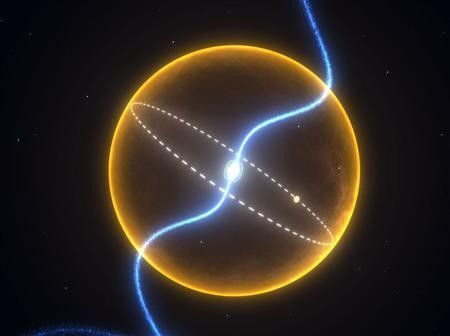Jupiter-Sized Diamond Planet Born Of Spinning Pulsar, Likely To Live Forever?

While looking for pulsars, a team of scientists discovered an exotic planet orbiting the fast-spinning pulsar. While the planet was stripped of most of its mass, it was discovered to be crystallized, worthy to be identified as genuine diamond.
The Jupiter-sized diamond planet lies 4,000 light years away, and is five times bigger than Earth, according to a team of astronomers, led by Professor Matthew Bailes of Swinburne University of Technology in Melbourne, Australia.
The planet orbits a millisecond pulsar known as PSR J1719-1438.
A pulsar, a rapidly spinning star that emits a beam of radio waves, is formed when the core of a collapsing star is compressed during a supernova, collapsing into a neutron star. A millisecond is a pulsar with a rotational period of about 1-10 milliseconds. In 70 percent cases, millisecond pulsars have orbital companions, visible as a bright star orbiting the pulsar.
The new pulsar PSR J1719-1438 is the second thought to have a planetary partner.
The steady pulses of energy omitted by the pulsar showed regular disturbance, leading the researchers to conclude that there is the gravitational pull of a small orbiting object.
The companion was found to be very nearby, because the diamond planet orbits the pulsar in only two hours and ten minutes.
Though the new found pulsar is tiny and compact, measuring only about 12 miles across, it has a mass of 1.4 times that of the Sun and completes more than 10,000 rotations every single minute.
As the remnant of a once-massive star that lost its outer layers, the diamond planet is estimated as 34,175 miles across, which is about five times Earth's diameter.
The planet has slightly more mass than Jupiter but is 20 times as dense. That is equivalent to 18 times the density of water, said Bailes.
Its discovery was made using the Parkes radio telescope of the Australian Commonwealth Scientific and Industrial Research Organisation (CSIRO) and the Lovell radio telescope at Jodrell Bank Observatory in Cheshire, and one of the Keck telescopes in Hawaii.
In this case, something with the mass of our sun has evolved to be something the mass of a planet -- quite extraordinary, astronomer Michael Keith of the Australia Telescope National Facility told Discovery News.
The mass suggests the components of the planet cannot be gases like hydrogen and helium as most stars, but heavier elements such as carbon and oxygen, and the immense pressure would force the carbon to form a dense crystal-like structure, much more closely packed than in a diamond on Earth, according to researchers.
The system shows a stable operation, and shows no sign of change - possibly for billions of years.
Of course, this also means that it could well have been around for a long time, just waiting for us to find it. Since it's likely to last for longer than the Earth or the sun, I would say that in this case, a diamond really is forever, Keith said.
However, whether the long-living diamond planet shares the beauty of Earth's diamond remains a mystery.
In terms of what it would look like, I don't know I could even speculate, said Ben Stappers of the University of Manchester. I don't imagine that a picture of a very shiny object is what we're looking at here.
The research is published in this week's Science.
© Copyright IBTimes 2024. All rights reserved.





















